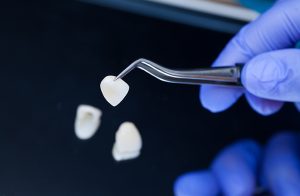Porcelain veneers are custom dental shells that hide the physical imperfections of teeth, such as the stains left on your teeth from years of drinking Grand Macchiatos. Porcelain veneers takes shape from the mould of your mouth. You can also use them as dental porcelain laminate. Veneers are thin, tooth-like slips that are protected on the outside of your teeth by a strong, mildly active gel.

Once they attach to the front of your natural teeth, these porcelain balls can do more than yellow marks and a grey tint. They change the shape of each tooth to hide deformities such as chips, cracks and rough edges.
About porcelain veneers
These porcelain veneers in Melbourne (or any veneers for that matter) will not straighten teeth, but will improve the appearance of damaged or discoloured teeth. They can also close up small gaps between teeth.
- Recommended age range: Porcelain veneers should only be applied to adult teeth. As gums degenerate with age, teeth may appear darker along the gum line as the undisturbed tooth enamel comes out.
- When will I see results: Porcelain veneer takes about two weeks, so don’t come to see the dentist and expect to receive porcelain veneers on the day of your appointment?
- Who should do it: Crowded teeth can lead to porcelain veneers—up to a point? Ask your dentist how much enamel needs to be removed for the veneers to be applied successfully. If you have gum disease, you will be excluded from the procedure until your gum has been treated.
- Advantages: The process is permanent. If you’re a commitment-phobe, don’t go for porcelain veneers. The porcelain veneers will bond to the teeth immediately. Your affected tooth may be sensitive to hot and cold temperatures for a few days to a week.
- Aftercare: To extend the life of your porcelain veneers, brush, floss, and schedule regular visits to the dentist. Because veneer traps plaque, get at least three professional dental cleanings per year. Trapped plaque can lead to gum disease and later root canals. Teeth can become dark and brittle after a root canal.
About resin veneer
Resin or composite, veneers are made from a putty-like material and then attached to the teeth. They can reshape, reshape and repaint teeth. Applying resin veneers to teeth requires permanent removal of the outer layer of tooth enamel, so the process is irreversible.
Composite resin veneers hide imperfections that damage your teeth. They can hide discolorations and repair gaps, chips and common age-related problems. Slightly overlapping or crooked teeth can be corrected with resin veneers.
- When will I see results: Composite veneers can be applied immediately to harden or denture, which takes less than an hour?
- How Long It Lasts: Despite being cheaper, resin veneers are less durable than porcelain veneers. They last an average of five years, about half that of porcelain veneers.
- Key Benefits of Resin Veneer: Unlike porcelain veneers, resin veneers can be created in a single visit to the dentist. They can also be repaired if they crack or break.
- Who Should Do It: Resin veneers can be moulded and bonded by cosmetic dentists, but you’ll want to make sure you’re familiar with composite materials as opposed to porcelain veneers? The more skilled the dentist, the more natural the joint veneer looks and fits closer to the gums. Poorly applied resin veneers can damage the gums when bacteria become trapped between the veins and gums.
- Aftercare: A tooth can be replaced in under an hour, but as you can imagine, the more veneers you get, the longer you’ll be in the company of your dentist. The pace of your placement ultimately depends on you.
![Porcelain Dental Veneers]()
Final thoughts
The final choice for choosing between porcelain veneers or resin veneers depends on your preference, taste and budget. There are many pros and cons of selecting both types of veneers. Contact Holistic Dental Melbourne CBD.


Comments are closed.